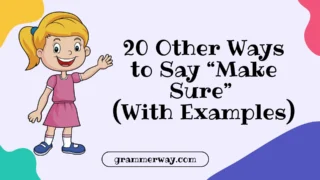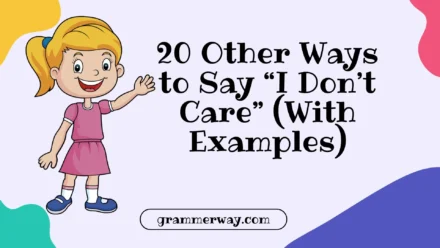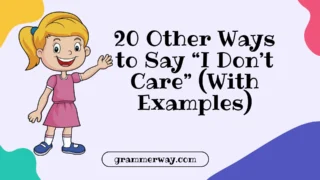Finding the right words to express ideas clearly is an important part of effective communication—especially when referring to written content. The phrase “In the text it states” is commonly used in essays, research papers, and discussions to introduce evidence, quotes, or explanations from a written source. However, repeating it too often can sound mechanical or repetitive.
That’s why exploring other ways to say “in the text it states” can make your writing sound more natural, confident, and engaging. In this guide, we’ll look at 20 thoughtful alternatives that bring warmth, clarity, and professionalism to your communication.
What Does “In the Text It States” Mean?
The phrase “In the text it states” is used when referring to specific information or evidence from a written piece. It signals to the reader that the upcoming words or ideas come directly from the text. This phrase is commonly found in academic writing, book discussions, or analytical essays.
It helps the speaker or writer connect their opinion or explanation with evidence from a source, ensuring their ideas are backed up with facts or quotes.
Is It Professional or Polite to Say “In the Text It States”?
Yes, it is professional and polite, especially in educational or formal contexts. However, it can sometimes sound too plain or repetitive. When used too often, it may make writing feel less natural or expressive.
That’s why knowing other ways to say “in the text it states” can help you vary your tone—whether you’re writing a report, discussing a passage, or analyzing literature.
List of Synonyms for “In the Text It States”
- The author mentions
- According to the text
- The passage explains
- The text suggests
- As stated in the passage
- The writer points out
- The article states
- As mentioned in the text
- The document indicates
- The source reveals
- As the text describes
- The passage highlights
- The author writes
- As observed in the text
- The reading shows
- The text demonstrates
- The evidence from the text shows
- As noted in the passage
- The author emphasizes
- The passage illustrates
1. The Author Mentions
Scenario: This phrase works perfectly when summarizing or paraphrasing what the writer has said in a text.
Meaning: This means that the author has made a statement or comment that is worth highlighting to support your explanation or analysis.
Examples:
- The author mentions that honesty is the foundation of strong relationships.
- The author mentions how society often overlooks simple acts of kindness.
- The author mentions that teamwork plays a vital role in success.
- The author mentions the importance of self-reflection for growth.
- The author mentions that small efforts can lead to meaningful change.
Tone: Professional, thoughtful, and respectful.
Explanation: This phrase is a clear, respectful way to refer to an author’s ideas. It shows that you are aware of the source’s viewpoint while connecting it naturally to your own writing.
2. According to the Text
Scenario: Ideal for referencing factual information, data, or clear statements made within the text.
Meaning: It indicates that the following information is directly drawn from the written material being discussed, not your own opinion.
Examples:
- According to the text, the company achieved record profits this year.
- According to the text, climate change affects every region differently.
- According to the text, teamwork increases productivity and motivation.
- According to the text, kindness is a universal language of compassion.
- According to the text, new policies aim to reduce environmental damage.
Tone: Formal, factual, and evidence-based.
Explanation: This phrase provides authority and credibility to your statement, helping readers understand that the information originates from a trusted source.
3. The Passage Explains
Scenario: Great when analyzing a specific paragraph or excerpt that provides clarity or reasoning.
Meaning: This phrase tells the reader that the passage provides an explanation or insight that supports your interpretation.
Examples:
- The passage explains how determination helps people overcome challenges.
- The passage explains that patience often leads to lasting success.
- The passage explains how technology influences modern lifestyles.
- The passage explains the emotional growth of the main character.
- The passage explains why small decisions can create big changes.
Tone: Analytical and reflective.
Explanation: This phrase works well in literature analysis or academic discussions, showing that you’re engaging deeply with the content.
4. The Text Suggests
Scenario: Useful when interpreting meaning or drawing conclusions that are not explicitly stated.
Meaning: It implies that the text gives hints or indirect evidence toward an idea or viewpoint.
Examples:
- The text suggests that love can heal even deep emotional wounds.
- The text suggests that courage grows from moments of fear.
- The text suggests how empathy builds strong communities.
- The text suggests that honesty brings peace of mind.
- The text suggests growth often comes through difficult experiences.
Tone: Insightful and interpretive.
Explanation: Use this phrase when analyzing themes or reading between the lines; it shows critical thinking and understanding.
5. As Stated in the Passage
Scenario: Commonly used when citing or summarizing exact wording from the text.
Meaning: It acknowledges that the upcoming idea or quote has already been presented in the text and is now being referenced.
Examples:
- As stated in the passage, success requires both effort and patience.
- As stated in the passage, education is a lifelong journey of growth.
- As stated in the passage, community support brings strength.
- As stated in the passage, small acts of kindness can change lives.
- As stated in the passage, perseverance is the key to achievement.
Tone: Respectful and academic.
Explanation: This phrase is formal and often used in essays or reports to introduce evidence or quotations accurately.
6. The Writer Points Out
Scenario: Perfect when summarizing a clear observation or claim made by the writer.
Meaning: This phrase communicates that the writer deliberately highlighted or emphasized a certain idea or fact in their work.
Examples:
- The writer points out that gratitude can shift our perspective on life.
- The writer points out how technology connects people globally.
- The writer points out that balance leads to a healthier lifestyle.
- The writer points out how hope helps people recover from pain.
- The writer points out that empathy strengthens human relationships.
Tone: Objective and professional.
Explanation: It’s great for both formal and semi-formal writing, showing that you are focusing on the author’s main argument.
7. The Article States
Scenario: This is often used in academic essays, reports, or online discussions when you want to refer to a published piece directly.
Meaning: This phrase means that the specific information or statement being discussed comes directly from the article, showing that you are referring to an established source rather than personal opinion.
Examples:
- The article states that daily reading improves both focus and imagination.
- The article states that kindness often inspires others to act compassionately.
- The article states that teamwork creates trust among employees.
- The article states that motivation grows when people feel appreciated.
- The article states that maintaining a positive attitude helps overcome challenges.
Tone: Professional, informative, and academic.
Explanation: This phrase shows respect for the original source, keeping your writing credible and fact-based. It’s a simple and polished alternative to “in the text it states,” especially when discussing online or printed articles.
8. As Mentioned in the Text
Scenario: Great for situations where you’re reminding readers of something that was previously discussed or highlighted in the text.
Meaning: It means that the idea you’re bringing up has already been stated or referenced in the same text or passage earlier.
Examples:
- As mentioned in the text, gratitude leads to a more positive outlook.
- As mentioned in the text, success comes through consistent effort.
- As mentioned in the text, honesty is essential for healthy communication.
- As mentioned in the text, respect is built through understanding others.
- As mentioned in the text, empathy makes connections stronger and deeper.
Tone: Respectful and reflective.
Explanation: This phrase feels conversational yet professional. It’s an excellent way to guide readers back to important points in a warm, natural way.
9. The Document Indicates
Scenario: Often used when referring to official documents, research papers, or reports that contain clear evidence or data.
Meaning: This phrase signals that the document presents information, data, or conclusions that you are referencing in your explanation.
Examples:
- The document indicates that stress affects both body and mind.
- The document indicates that training improves employee confidence.
- The document indicates how communication builds stronger relationships.
- The document indicates that planning helps reduce future risks.
- The document indicates that teamwork encourages creativity.
Tone: Formal, professional, and clear.
Explanation: This phrase is useful in workplace or research contexts because it demonstrates precision and reliability, aligning your statement with verified information.
10. The Source Reveals
Scenario: Best for when you’re discussing something discovered or uncovered in the text that provides valuable insight.
Meaning: It means the source gives readers new understanding or meaningful information that supports your point.
Examples:
- The source reveals that compassion often leads to long-term trust.
- The source reveals how habits shape a person’s future success.
- The source reveals that community support reduces loneliness.
- The source reveals that positive feedback builds motivation.
- The source reveals the deep impact of emotional intelligence in leadership.
Tone: Insightful and analytical.
Explanation: This phrase adds a thoughtful and investigative touch to your writing, perfect when the text provides hidden meaning or deeper analysis.
11. As the Text Describes
Scenario: Works beautifully when discussing specific descriptions, imagery, or storytelling details found in a passage.
Meaning: This means that the text gives descriptive information or context that adds to your understanding of the topic.
Examples:
- As the text describes, the landscape symbolizes peace and freedom.
- As the text describes, the main character struggles between fear and courage.
- As the text describes, friendship gives meaning to the story’s journey.
- As the text describes, the author paints emotions through vivid imagery.
- As the text describes, love brings hope even in dark times.
Tone: Literary and expressive.
Explanation: This phrase helps readers visualize what the text conveys, creating a smoother and more personal reading experience.
12. The Passage Highlights
Scenario: Ideal when the text emphasizes or underlines a key point or message.
Meaning: It suggests that the passage gives special attention to a particular idea or theme that is worth noting.
Examples:
- The passage highlights the importance of compassion in leadership.
- The passage highlights how self-belief leads to growth.
- The passage highlights the power of forgiveness in relationships.
- The passage highlights how determination turns dreams into achievements.
- The passage highlights the value of kindness in daily life.
Tone: Confident and focused.
Explanation: This phrase feels strong and purposeful. It directs attention to what truly matters in the text, helping readers grasp the writer’s main point with clarity.
13. The Author Writes
Scenario: Great for quoting or paraphrasing directly from the writer’s words.
Meaning: It means the author has written something clearly and intentionally, which you are now referencing in your analysis or discussion.
Examples:
- The author writes that hope gives meaning even during hardship.
- The author writes that balance helps people live peacefully.
- The author writes about courage as a path to self-discovery.
- The author writes that kindness reflects a person’s inner strength.
- The author writes that challenges shape our true character.
Tone: Respectful and straightforward.
Explanation: This phrase gives credit directly to the writer, maintaining professionalism and clarity without sounding repetitive or stiff.
14. As Observed in the Text
Scenario: Useful when describing something you have noticed or interpreted within the passage.
Meaning: This phrase shows that you are making a careful observation about the text’s meaning, tone, or theme.
Examples:
- As observed in the text, courage often appears in quiet actions.
- As observed in the text, patience brings understanding and wisdom.
- As observed in the text, love inspires change and forgiveness.
- As observed in the text, fear can motivate or limit growth.
- As observed in the text, teamwork leads to mutual trust.
Tone: Reflective and interpretive.
Explanation: This phrase blends analytical depth with a human touch, making your writing feel thoughtful and aware.
15. The Reading Shows
Scenario: Best used when discussing evidence or information drawn from assigned reading material.
Meaning: It means the reading demonstrates or proves an idea or point that supports your discussion or conclusion.
Examples:
- The reading shows that empathy improves social understanding.
- The reading shows how gratitude changes perspectives.
- The reading shows that leadership grows through experience.
- The reading shows that hope inspires perseverance.
- The reading shows how teamwork strengthens relationships.
Tone: Academic yet simple.
Explanation: This phrase is commonly used by students and teachers alike. It keeps your response structured, professional, and easy to follow.
16. The Text Demonstrates
Scenario: Great for connecting evidence and interpretation in essays or research writing.
Meaning: This phrase means the text provides clear proof or illustration of the point being discussed.
Examples:
- The text demonstrates how resilience builds confidence.
- The text demonstrates that small actions can create large impacts.
- The text demonstrates how kindness brings emotional peace.
- The text demonstrates that perseverance leads to growth.
- The text demonstrates the importance of staying true to values.
Tone: Logical and persuasive.
Explanation: It’s an excellent phrase for analysis, as it shows you can draw meaningful conclusions based on what’s presented in the text.
17. The Evidence From the Text Shows
Scenario: Common in academic writing when you’re using quotes or references as support.
Meaning: It emphasizes that the conclusion or statement comes directly from textual evidence, not assumptions.
Examples:
- The evidence from the text shows that honesty creates trust.
- The evidence from the text shows that courage leads to self-discovery.
- The evidence from the text shows that teamwork fosters success.
- The evidence from the text shows that love transforms fear into hope.
- The evidence from the text shows that patience builds strong character.
Tone: Formal, reasoned, and authoritative.
Explanation: This phrase strengthens your argument by grounding it in textual proof, making your analysis convincing and well-supported.
18. As Noted in the Passage
Scenario: Suitable when you’re referring to something already mentioned or highlighted within a text.
Meaning: It shows that you are reminding the reader of something that was previously mentioned or noted by the author.
Examples:
- As noted in the passage, friendship brings comfort in hard times.
- As noted in the passage, kindness creates lasting connections.
- As noted in the passage, challenges teach valuable lessons.
- As noted in the passage, respect strengthens human bonds.
- As noted in the passage, gratitude improves emotional well-being.
Tone: Gentle and academic.
Explanation: It’s a subtle and polished way to reference information without repeating “in the text,” giving your writing smoother flow.
19. The Author Emphasizes
Scenario: Ideal when the author strongly focuses on or repeats an important idea throughout the text.
Meaning: It means the writer wants the reader to pay close attention to this key idea because it carries strong meaning or message.
Examples:
- The author emphasizes that honesty brings freedom and trust.
- The author emphasizes that growth requires patience.
- The author emphasizes that kindness makes the world better.
- The author emphasizes that persistence leads to progress.
- The author emphasizes that compassion brings healing.
Tone: Analytical and strong.
Explanation: This phrase communicates focus and intention, showing readers that you understand what matters most in the text.
20. The Passage Illustrates
Scenario: Works well for explaining examples, imagery, or storytelling used in writing.
Meaning: This means the passage gives clear evidence or visualization of a concept or emotion through storytelling or details.
Examples:
- The passage illustrates how love brings peace after conflict.
- The passage illustrates that teamwork creates success.
- The passage illustrates how dreams inspire change.
- The passage illustrates the beauty of resilience.
- The passage illustrates the power of forgiveness.
Tone: Insightful and descriptive.
Explanation: This phrase adds color and emotion to your analysis. It invites readers to see what the author meant through vivid imagery or expression.
Conclusion
Finding other ways to say “in the text it states” helps you express yourself with warmth, professionalism, and clarity. Whether you’re writing an essay, discussing literature, or analyzing information, these phrases help you connect ideas smoothly and naturally. By varying your wording, you keep your writing fresh and engaging — while still sounding informed and thoughtful.
FAQs
1. What can I use instead of “in the text it states” in essays?
You can use phrases like “according to the text,” “the author mentions,” or “the passage highlights” to sound professional and varied.
2. Is it okay to use “in the text it states” in formal writing?
Yes, it’s acceptable, but using alternatives can make your writing smoother and more engaging.
3. How can I make my analysis sound more natural?
Try using conversational alternatives like “the author points out” or “as mentioned in the text” to keep a warm and thoughtful tone.
4. What is the best phrase for quoting directly from a book?
Use “as stated in the passage” or “the author writes” when including a direct quotation.
5. How do I choose the right phrase for each situation?
Consider the context: use formal phrases like “the document indicates” in reports and softer ones like “the passage highlights” in discussions or essays.







Leave a Comment